
VictoryXR: Shaping the Future of Education with VR
- September 21, 2023
Listen and Subscribe on Your Favorite Platform:
Episode Summary
In this episode, we dive deep into VictoryXR’s origin story, exploring how founder and CEO Steve Grubbs’ experiences in politics and entrepreneurship shaped the company’s unique approach to education. VictoryXR is currently one of the leading content creators and developers for virtual reality in education. Founded in 2016, VictoryXR is at the forefront of producing award-winning virtual reality curricula for schools.
We discuss their VR content modules and talk about how to provide equal access to all students with exciting, immersive experiences. We discuss unique challenges to VR adoption in education and the importance of having a plan both for VR pilot programs and for scale.
Steve also discusses the meaningful impact and eye-opening statistics on the impact of their “Metaversity” compared to traditional schooling and how their partnership with Meta is transforming education through virtual reality. Their innovative concept of “Metaversity” introduces digital twin metaversities, offering virtual reality experiences of campus grounds. Notably, Metaversity has seen exceptional student satisfaction, engagement, and achievement rates, surpassing traditional and online schooling.
Join us as we explore the exciting possibilities of VR-based education and the future of XR in the educational space.
Key Moments
- Steve’s background/what led to VR (01:12)
- Steve’s motivation (03:13)
- Origin of VictoryXR, what they’re focusing on now (05:38)
- What is VictoryXR (06:55)
- Use case (10:50)
- The reach/Morehouse College (10:51)
- Experience of user (13:24)
- How the course augments existing courses (15:58)
- How do professors make the shift / the process (17:39)
- Why VR? (18:45)
- To Kill a Mockingbird example (21:27)
- How VictoryXR cracked into K-12 (22:22)
- Hardware partnerships (23:57)
- Pain points (25:21)
- Role in guiding schools they’re working with (29:38)
- Projects at VictoryXR (VXR and Traveler App) (31:13)
- What does education look like as VR matures / outro (40:39)
About the Guest
Steve Grubbs is the co-founder and CEO of VictoryXR. After founding the company in 2016, Steve lead the VXR team to winning the Global Education Innovation of the Year award in 2021. Before founding VXR, Steve founded two other successful ventures. Steve served in the State of Iowa legislature from 1991-1997, sitting as Chair of the House Education Committee. He holds a B.B.A. in Finance and J.D. from the University of Iowa.
Links and Resources
Learn more about getting started with XR in our ultimate guide to managing VR training for work.
Episode Transcript
Brad Scoggin: Hey there, welcome to “XR Industry Leaders” with ArborXR. My name is Brad Scoggin, and I am the CEO and one of three co-founders of ArborXR. And we’ve had the opportunity of working with thousands of companies since 2016, and we’ve learned a ton about what it takes for XR to be successful in your organization.
Will Stackable: And I’m Will Stackable, co-founder and CMO. This podcast is all about interviewing the leaders who are on the ground making XR happen today. True pioneers in the space from Amazon, Walmart, and UPS to Koch, Pfizer, and beyond to uncover the pitfalls, lessons learned, and secrets that you can use to help grow XR in your organization.
Brad Scoggin: All right, well, today we are going to take a bit of a deep dive into VR and education and we get to sit down with the founder and CEO of VictoryXR. Steve Grubbs. Steve, it’s great to have you on the show today.
Steve Grubbs: Well, I’m excited because this show and the Joe Rogan show, those are my podcast life goals and one of two down.
Brad Scoggin: Well, glad we could play a role in checking off a bucket list there. Steve, we always love to start with a little bit of the origin story, and obviously today you’re doing a lot of really cool stuff. You’re partnered with several of the major hardware companies to bring VR education to universities and high schools and K through 12. You have a really interesting background. You started several companies, you’ve been involved in politics. Maybe just give us a little bit of your background and what in that mix of business and politics, politics led you into VR and education.
Steve Grubbs: My father was a middle school public school teacher, and here’s a story I’ve never told before. In eighth grade, I helped him in shop class. I helped him build a little buzz box so two students would come up, they’d ask a question, whoever knew it first would buzz and that person would answer. If they got it right, they got a little mini candy bar. That was my first time innovating in education. I actually had my father as a teacher and so that was pretty cool getting to use something that I had built with him.
I’ve always had an interest in education. When I was young, 24, I ran for the Iowa Legislature, surprised a lot of people and won. Two years later I was named Chair of the House Education Committee and went to work trying to resolve issues in learning in Iowa. There’s a lot of them just like everywhere else. The high watermark for me was the passage of a bill that I wrote, which was the Technology Funding Bill provided funding to every school in the state to connect to the internet, build computer labs, that type of thing. Having said that, it still didn’t achieve the ultimate goal, which was to really create a love of learning in students. That’s where this conversation ultimately comes to.
Brad Scoggin: I love that. Tell me, what’s the motivation for you? Why the desire to create a love of learning in students?
Steve Grubbs: Well, I don’t know why, because I was a policymaker for a number of years, but I’ve just always had this thing that overwhelms me of how do we solve these problems in society? Fundamentally, one of the very few things that really makes a big difference is education, learning. If students succeed in school, then it’s going to solve a lot of problems with crime and employment and just good critical decision making at a national level. That’s very important to me. I was a high school debate coach, and so these are things that I’ve invested time in and I think what we have built at VictoryXR really creates a love of learning, whether you’re talking about history or literature or science, it’s all happening.
Will Stackable: I think it comes through. So many of your, especially the 360 tours, I could just tell there’s a real passion for the history there and man, you’ve had the privilege of traveling a lot as part of that. I’m sure that’s been fun.
Steve Grubbs: Yeah, telling some of those stories, stories that people don’t even know about. For example, in June we told the story of William Wilberforce. Very few people know the story of William Wilberforce, but really in the abolition of slavery globally, there is no single person on the planet that contributed more to that than William Wilberforce. His story of persistence is worth telling. We went to London and told that story and we’ve done the same thing with D-Day, the Velvet Revolution in Prague, which most students have forgotten about, the Kings of Egypt and the Queens of Egypt. It’s really something that I enjoy doing and I also know students enjoy it.
Brad Scoggin: Yeah, that’s very, very cool. Well, tell us, so you’ve got this political background that was focused on education and then you started several companies, and then 2016 you jump into VR, at least that’s what I understand. What was that transition like? VictoryXR has been around as long as almost any company in VR that has survived. You’ve seen a lot. Tell us about the origin of that and then maybe bring us up to speed with what you’re doing and what you’re focusing on specifically today.
Steve Grubbs: Yeah, one of the advantages that I had was that I had started other companies and had to bootstrap them. How do you make payroll when there’s not enough money coming in? How do you make rent? All of those things. Being an entrepreneur, there’s certain key learnings that I had developed over the years of starting other companies and I was able to bring those to the fore in this instance. Obviously 2016 comes around, we think that virtual reality is going to bust out of the gates in a big way and it busts out of the gates in a slow way. It was more of a turtle race than a rabbit race. Fine, part of succeeding is A showing up and B lasting. A lot of people bailed out over the last seven years. I think our persistence has paid off. We’re a global leader and we’re positioned now to enjoy the uplift in interest of it globally.
Brad Scoggin: Well, maybe just as we transition into talking specifically about some of your initiatives today, give us your elevator pitch on what is VictoryXR today? What’s the focus? What are you doing?
Steve Grubbs: Yeah, we’re the leader in providing multi-player synchronous learning for science, history, literature and some math. What that means is that teachers can come into the space, they can teach a live class for online students. This is the place where hands-on learning intersects with online learning, which is really important. That’s what we’ve developed. We’ve got our own platforms, we have our own content. That’s pretty long for an elevator pitch, but that’s a long ride. That’s what we’ve been able to deliver. It can be asynchronous, single user, single student as well, but teachers have the ability to choose which path they want.
Will Stackable: I love that. Actually, the first part of that elevator pitch, I was thinking, I don’t know if I could do it that succinctly with Arbor. Can you give us a use case or a story that illustrates everything you’re doing in a nutshell?
Steve Grubbs: There is a lady in Kansas City who runs a program for urban schools, and she called me one day and she said, “Could I use the forklift driving experience for my grandson? He’s not a student, the license wasn’t written for this, but he’s sort of struggling right now and if I could do that, that would be great.” She gave him a pep talk, she gave him a headset, she gave him a license to the forklift driving experience. He had fun doing it. He learned everything he needed to do to pass his forklift certification, and then he passed it and got a job driving a forklift, and suddenly his life was completely different. If you think about that, where do you get to go to drive a forklift to learn? You have to be hired first and then they’re going to let you use the forklift.
This is the radical transformation. This is the thing that delivers equality in facilities. An opportunity is giving students access to things like welding or forklifts or robotics or drones or in the example of some of our schools, chemistry labs and biology labs, giving them access to this in a dramatically affordable way changes everything. That one isolated incident is just one of hundreds or thousands of students who have learned skills or knowledge that they would not have otherwise had access to.
Brad Scoggin: Yeah, that’s so good. We talk a lot about, since we started doing this show we get to sit down with a lot of cool people doing cool things in VR. I say it often, but it really feels to me that VR is enabling a learning revolution. We’re seeing, I think some stats say people learn four times faster and it’s the frontline worker at Walmart or it’s the doctor, people retain 16 times more information. One thing you just hit on, which I think is so important, we actually don’t mention it that much, is just the accessibility of education, of the best training and getting ahead of time. We’ve talked to some groups that do nurse training and they said the exact same thing. You get to practice before you even start, which I think is just so powerful. I love to hear the story of the one. Well, also though very curious in just your overall reach today, you’re focusing on, is it K 12 and universities? Is it primarily high schools and universities? What does that look like?
Steve Grubbs: Yeah, so early on we were mostly K-12.
Brad Scoggin: Okay.
Steve Grubbs: Then in 2019 we built our first higher ed lab. Then in 2020, Morehouse College came on board. They were our first university because students were tired of learning in Zoom. We built them a Metaversity campus, a digital twin of their actual campus. The students came on from wherever they were at home, a library, whatever, and they joined their professor and other students on the Morehouse College campus, the digital twin version. Then they went to class and took chemistry and history and other courses
Before I talk about how many schools were in it, I just want to stop and talk real quickly about the Morehouse college study. Professor Oval Hamilton teaches world history. He’s a retired United States Navy officer, and he taught the exact same world history course in a brick and mortar classroom through an online platform like Zoom and then on the VR Metaversity campus. At the end of those classes, they looked for three points of data. Number one, what was the student satisfaction level, how much did they appreciate it and like it second, what were the grades that students got in each of those ways that it was delivered? Then third, how was class attendance, how was engagement on all three of those measures the Metaversity class was head and shoulders above the other two, and why wouldn’t you be? If you’re teaching world history and you can hop into a time machine, pretty cool. Students remember more, et cetera, et cetera.
That was our very first school. A year later, we had two schools. Today we have 107 colleges or universities around the world, and we expect that to be in the range of 150 by the end of the year. Then by the end of 2024, we expect that to be closer to 400. We’re seeing accelerating adoption and our products are getting better. It seems great. That’s about 10,000 students that have learned from 90 different courses that were taught in the 2223 academic year.
Will Stackable: That’s awesome. Can you give me just a window into, I’m a student at Morehouse College or any of these universities that you’re working with, day one do I get shipped a headset? I put it on and I’m in, give me 30 seconds on what’s the experience for the end user?
Steve Grubbs: Yeah, if you think about University of Maryland global campus, if you’re a residential campus, you might have a group of headsets, students walk in, grab their headset, and they’ve got it for the course, for the semester, whatever the case might be. If you’re UMGC, your students are all over the United States. We’ve worked with them to put together a program where we ship out the headsets, they come back in. The nice thing is, just to date myself, I was the very first student on my dorm floor at the University of Iowa that had a personal computer. The only student. Yeah, my future wife would come by and type her papers. That was a pretty good ploy. Yes. I’ve seen how this adoption works. All the rest of the students had to walk from our dorm to the computer center to get access to computers. People see somebody has a personal computer, they want one, they’re not that expensive, et cetera.
About a little less than 10% of incoming freshmen have a VR headset, and that number is growing. As this rolls out as a way to learn, students will stop walking to the lab and they’ll just pull their headset on from their dorm room or their apartment or wherever they might be. If you are at one of the big online universities like Purdue Global, UMGC, Western Governors, Southern New Hampshire, et cetera, I think that what we’re going to start seeing very soon are courses that are, “Here’s a course that’s online, here’s a course that’s VR. If you have a VR headset or you’re willing to acquire one, sign up for it.”
Will Stackable: Interesting.
Steve Grubbs: UMGC has 60,000 students, Western Governors has 130,000 students, that largely resolves the hardware issue because those students who have them, so let’s say it’s 10% of students for easy math, and your Western governors with 130,000 students, that means that 13,000 of your students have headsets already. Why not offer them some courses on a Metaversity campus? It just makes sense and it makes your school or university more attractive.
Brad Scoggin: Yeah, that’s very cool. One question I always have, we’ve been around almost as long, probably about the same amount of time as your company and early days we did some pushes into education. One of the biggest challenges for us that we’ve seen over time was how the course augments the existing courses. Talk to me about, to me that’s the people component. You got to sell the university, you got to sell the professors, you got to make sure the content you’ve created is it augmenting the class they’re taking? Is it fully in VR? Tell us a little bit about that.
Steve Grubbs: Our approach to solve this problem was that we essentially train the professors to teach their course however they want it. We don’t have to create new curriculum for every course in college because there’s probably a hundred thousand different pieces of curriculum in higher education across the United States, around the world. What we have to do is provide the facility. If you think of the analogy of an existing atom-based building, somebody provides that professor a building, they provide them the chemistry lab, they provide them the whiteboard, whatever they might have, and then the professor teaches whatever they want to teach. That’s what we do. We provide them the Metaversity campus. We provide them over thousands and thousands of 3D objects. No matter what they’re teaching, we provide those objects. We provide simulators, all of these things, and that allows them to teach the way they want to teach.
Brad Scoggin: Is it difficult to get the professor on, it sounds like that’s a lift for them to redo their entire course in VR. What’s that process like?
Steve Grubbs: They don’t have to redo anything. Let’s say that for example, it’s a history course. Let’s go back to the example with Professor Hamilton. He would teach about the impact of railroads in Africa. Now he’s just teaching the exact same thing, but now they’re learning that on a freight train in Africa, when he teaches World War II history about the South Pacific, he’s showing videos from World War II. He’s doing this and that, but the students are all sitting in chairs on a battleship floating in the South Pacific.
Brad Scoggin: Got it.
Steve Grubbs: It’s not a lot of extra lift on him. That’s why we do this professional development training so they understand that you don’t have to do a lot of extra work. You do have to figure some things out, but it’s not a real heavy lift.
Will Stackable: A question we get sometimes, and this is just across the board not even just in education, is why VR? Why do you need VR if we have high quality simulations, kids interact with 3D all the time just on a flat screen? What’s your answer to that for education when it comes to why VR matters, why it’s better?
Steve Grubbs: Yeah, I’m going to address that two different ways. One from the K-12 angle. In Chicago on the North Shore, if you don’t know the North Shore, that’s where the money is. Their taxpayers approved a very nice STEM center, $10 million plus. The kids on the North Shore, good for them, have access to this really advanced STEM center. What do we do about the kids on the south side of Chicago? Do we just say, “Eh, that’s the breaks. You were born in the wrong place.” This is the way you give them actual access to 3D labs, just like the kids on the North Shore. To say, “Oh, you can use this on a Chromebook or a PC and just sort of click and push things around.” That’s not real learning, real learning you have to be able to use your hands. We know this from everything, whether it’s from repairing a car to medical surgery, nobody learns those things just clicking and pushing things on a screen. The hands-on piece, very important. That’s at the K-12 level.
In higher ed, that example also carries through, but also more important in higher ed these days is that 40% of students are taking at least one course online. Again, how do you learn chemistry in a 2D world? How do you mix beakers and do those sorts of experiments? How do you learn in a cadaver lab in a 2D world? You can’t. You can, but it’s not nearly as effective as students who get to learn in a 3D world. A lot of times we’re US-centric, but these sorts of facilities and labs are available in some places in the United States, but non-existent in many countries in the world. As this rolls out, it’s a dramatically great paradigm shift in the way that learning is delivered.
Brad Scoggin: That makes sense. With the Metaversity, you’ve got a chemistry professor that’s now teaching their course in a VR environment, so the students can engage with that remotely, but also there are additional apps that they can engage with to see molecules or whatever so it brings it both together. That’s cool.
Steve Grubbs: The thing as simple as literature, sorry to interrupt.
Brad Scoggin: No, go ahead.
Steve Grubbs: Part of the challenge of teaching is you can teach all you want, but if students don’t gain understanding, if the scales don’t fall from their eyes, then you haven’t pushed the ball down the field. You think about To Kill a Mockingbird, we rebuilt the courthouse. We will have the author of To Kill A Mockingbird sitting in there as a conversational AI so students can just ask her about the book. They can learn what it was like to be considered a second class citizen and be forced to sit in the balcony or sit below. Suddenly literature has more meaning because students can experience it. That’s a big part of our goal with education.
Brad Scoggin: That is very cool. I have a question about your early days in K-12, because that was an area we tried to push into early on as well, and it wasn’t our core focus, but it just felt so challenging before there were standalone devices. Could you just tell us a little bit about how did you crack into the K through 12 early on and how that’s evolved?
Steve Grubbs: Yeah. Everything in life is a bell curve, thank goodness. If you think about the world of K-12 schools, you’re going to have two-thirds in the first standard deviation, and that’s going to be, it’s interesting. Someday we’ll pursue it. On the good side, you have that second standard deviation where they’re interested and they’re trying to figure it out. Then you have that third standard deviation. They got the money, they have the know-how, they just need a vendor and they’re going to make it happen. What we had to do to succeed was to surface those in the third standard deviation, the few leading edge people who said, “Yeah, we’ll buy five computers and connected headsets, tethered headsets, and then we’ll use your dissection and we’ll use other products and we will jump into this.” Some of it was done with grants, some of it was done with technology budgets, but we found enough to survive and we did a deal with Microsoft, and that helped as well. We won a big contest with HTC Vive. We just kept cobbling it together in the early days.
Brad Scoggin: That’s very cool. You mentioned HTC Vive. Tell us about some of your hardware partnerships today. I know you’re working with several of the big players on some initiatives, so maybe share a little bit about that.
Steve Grubbs: Yeah, we’re fortunate to have many of the world’s largest tech companies as partners with Meta. They’ve given us very significant grants to build metaversities around the United States, 30 of them to be exact. With HTC Vive, we are the sole content provider for their school headsets with Pico. They are active with us distributing our business training bundle, the forklift and fire extinguishers and defibrillator and OSHA warehouse. Then Lenovo, they distribute on their Vive flow, our Global Traveler app with 130 global fields trips for students. Beyond the device makers, though, we’re also fortunate to have Qualcomm and T-Mobile who fund a lot of the R&D. They have an interest in seeing that these devices with chips are out everywhere and they’re accessing five, six G. We work together to try to figure out these issues and how it might deploy in the future, but we’re very fortunate.
Will Stackable: Let’s dive in a little bit to some of the nitty gritty. You’re talking about headsets and different device types, and what do you see are some of the current pain points to going to scale either in the industry or specifically for schools that you work with?
Steve Grubbs: Yeah, I was on with the school this morning and they’re trying to figure out how do we limit students to just the educational experiences that you provide? They said, “Can you do that?” I said, “Well, it’s limited right now. You need to find a partner like ArborXR, or you need to, at some point, meta will have an enterprise platform that will at least for their headset, provide more tools for educators. At the current time, you got to have a management platform like Arbor.” That’s a pain point, is helping them figure that out. It’s really not the cost of hardware. The cost of hardware is, it’s frankly less than a Chromebook. I don’t think that’s it. I think really the big issue is understanding and willingness to try something new. There are enough friction points that it’s a challenge to get people to try something new because A they first have to have understanding of the dramatic impact it can have. Then second, they have to invest the time to figure it out and to stumble through it in the beginning. People always expect like, “I’m just going to pop on a headset and it’s like joining a Zoom meeting.” I say, “You know what? Remember when you learned to drive, you went through six weeks of learning. Well, this isn’t that hard, but you might have to spend six hours trying to learn how to maximize the hardware and the software, but it’s not six minutes.”
Will Stackable: I want to double click on some of those conversations you’ve had with schools. We oftentimes see this with organizations where they get excited, they do a pilot early on, they are just doing everything, hacking things together. It just doesn’t matter. They’re just trying to see if it works. At some point it works, they get excited about it, and then they want to start building out and scaling out. That’s where the people, processes and technology start. The basic things like how are we going to get wifi set up on all of these devices? Beyond even, we can talk about device management, obviously that’s important and something we’re interested in, but what other pain points if you give us a landscape of when you talk to schools and they get excited whether it’s Morehouse or anybody else, what are the other issues they run into as they start to want to scale things up?
Steve Grubbs: Yeah, obviously different schools have different issues. Sometimes it’s a bandwidth issue. They will need to segregate off a portion of their bandwidth for VR. Sometimes it’s a firewall issue. We run into firewall issues all the time, and that’s a lot of times you just say, “Look, you need device management.” Beyond that, sometimes they will have, not very many students have problems in VR, but there are some students who do have issues with virtual reality. We had to build our VXR web platform so that students could access it through Chromebooks, PCs or MacBooks. When you start a new company like I’ve done before, you can’t always anticipate the roadblocks or friction points, but you need to have a workable solution at a basic level. Then as you run into these additional problems, you tackle them one by one, you figure out a solution, maybe a couple of solutions, and then you have to commit it to writing or commit it to a video like we do so that people will understand that if you run into an issue, it’s not the end of the road, it’s just something you got to drive around.
Will Stackable: Something I’ve noticed with your team and just your progress over the years is that you’ve managed to come alongside schools and universities and other organizations at an early stage. You talked about early on, they’re plugging headsets in, there’s cables, they’re wheeling PCs from classroom to classroom. How much of an active role do you have to play even now in terms of really guiding, providing feedback, coaching, et cetera, even support to some of the schools and universities and other organizations you’re working with?
Steve Grubbs: Yeah, it’s surprisingly little. For the most part, schools these days, and especially universities have a whiz kid IT guy, gal who they figure it out, they get it, they probably have a VR headset and they know their firewalls. Once we walk them through it, that’s the person that gets called, not us. That’s really helpful. Occasionally people have an issue maybe with the way we’ve developed the content or maybe they don’t have an IT person that can be helpful. In those cases, we’re on standby, we’re ready, willing and able to help. I’ve always planned on building a bigger customer support base of employees to resolve these issues, and I’m shocked at how little we actually get called.
Brad Scoggin: That’s great. I love that you find your champion on site and then they take it from there. You mentioned this briefly, but I know you’ve got a couple new initiatives that you’ve either recently launched or are launching. One is the VXRLabs and then also a new app, a Global Traveler app. Maybe share a little bit about both of those.
Steve Grubbs: Yeah. VXRLabs is really the most advanced 3D immersive learning platform in the world, and it is for three reasons. One, it’s synchronous or asynchronous in nature, which there are other platforms like that, but very important. And second is we now have enabled conversational AI avatars. What that means, I’ll give you an example for a nursing student. A nursing student goes into the Emergency Room. There’s a patient who’s complaining of chest pains. We all know if they’re complaining of chest pains, they may not have much time. The nursing student can have a live, or the doctor student, can have a live two-way conversation with that patient. The patient’s answers are not scripted, they’re not prerecorded. It’s all driven by conversational AI. We have put the information into that patient’s head, and that patient then replies with, you can ask it, “What’s your family history? What did you eat this day? What activities did you engage in?” All the common questions that would be asked, that information is in their brain, things you could ask them, what their favorite meals are, that has already been uploaded to give them some personality as well.
Also, think about, we’re just now rolling out Thomas Edison’s lab and George Washington Carver’s labs. You can go in there and touch and feel and learn about the things they invented. Even more than that, you can walk over into the corner where Thomas Edison’s sitting there and have a live conversation with Thomas Edison. You can ask him why he invented it, what were the challenges, all of these things, because we have uploaded into their brain everything they ever wrote. All first person information, and then a lot of additional information about them and the time period they lived in. That really changes the learning opportunities with that second component, conversational AI avatars. We also have a teacher coming out that way.
The third component of that are simulators. Very few platforms, almost none allow true simulators. We’ve all played flight simulator. Uploading flight simulator onto Altspace back in the day was not possible. We have actual simulators so that nursing student can put an EKG on that patient suffering chest pain, and then get a true readout and decide is this person dying or do they just have indigestion? That’s really the power of it. We’ve got a welding machine and a drill, and we have a drone and so many other simulators that are rolling out that just changes the ball game for learning VXRLabs.
Will Stackable: Quick, I want to ask a follow up there if we can before we move on to the Traveler app, the conversational AI piece, obviously it’s a big topic. I’ve seen a number of simulations or demos on social and LinkedIn where people have tried to do this and there’s challenges around just the lag time and also not having responses go off the wall, or I’m imagining kids asking some question that they takes them into some territory that the teacher would not be happy with. How do you navigate, you don’t have to get too technical, but do you feel like at this point is it at the prototype stage or is it working well and responding quickly and you’re happy with it?
Steve Grubbs: Yeah, so the lag times are an issue that we’ve worked a lot on, and some of that depends on your internet connection as well. We’ve gotten the lag time’s down pretty short. I would say shorter. If you ever ask Google, I got to be careful if I do this it’ll actually start talking to me. If you say, “Google”, you have a bit of a lag time. You say, “Hey, what’s the temperature? What time of day is it?” Whatever. You have a little bit of thinking time for Google or Siri or whatever the case might be. Ours seems to be shorter than that. There is this moment, and we’ve actually thought about putting people, you and I, we do this as well. We need a second or two seconds before we’ve got our answer formulated. We go, “um” and then we answer. We put that filler sound in there, and so we’re playing around with that, seeing if we can put that in.
Will Stackable: That’s clever.
Steve Grubbs: Our engineers have solved a lot of problems, and so we’ve rolled it out and rolling it out in a bigger way over the next four weeks.
Will Stackable: That’s awesome. We’ll share a link on the show notes for that. I’m sure people will want to check that out. Everybody’s thinking about, I have yet to try one that feels like it would be ready for real time, and I would love to get my hands on it. I should have done that before the show, but I’ll definitely do that after.
Steve Grubbs: I’ll share a YouTube video with you that we haven’t made public yet, but I’ll make available for your show.
Will Stackable: Well, let’s go to the Traveler app. I know that’s something even, I think I messaged your team awhile back. I want to get on some of these tours. You guys have such a, you have over a hundred travel experiences? Is that right?
Steve Grubbs: 130 and adding more all the time. Here’s the thing why this is important. How many students, and again, this is largely an income-based deal, but if you come from a wealthy family, you probably get to travel to Europe and elsewhere. If you are from South side of Chicago, you probably are not getting out of Illinois very often or Indiana. What if we were able to give students the ability to travel the world and expand their horizons? What does that do to the mindset of a student as they think about their future? We have a 130 360 VR field trips. They can be deployed to either a 3-DoF headset. If you don’t know what that is, Google it or a 6-DoF headset.
That matters because now a student can, for example, we just did Luxor Egypt where the Valley of the Kings, and we go down into King Tut’s tomb. That’s pretty cool. How many of us have gotten to stand in King Tut’s tomb? Well, I have for real. Now students all over the world can be down there themselves and see what it’s like, and not just pictures of it or a 2D video. They can look up and see the ceiling. They can look down and see the floor. They can look all around and also learn about King Tut because we add a lot of other things to it. I had an Egyptologist, help us out with this from the University of Cairo. We shot three field trips, Luxor Temple, Karnak Temple, and the Avenue of the Sphinxes.
I’m just going to take 15 seconds more because this is cool. The Avenue of the Sphinxes is 1300 sphinxes that line a three kilometer path between the Karnak Temple and the Luxor Temple. Nobody knew this existed 70 years ago. It had been buried under sand and a town had been built on top of it for, I think it was 3000 years. It was gone. Then they discovered it and they began excavating. They discovered it in 1949, began excavating a little bit in the seventies. Then about 15 years ago, they went all in and they uncovered, they had to move these stores and homes off the top of it, and they opened up this three kilometer walk. For the first time in 3000 years, human beings were able to walk on it in November of 2021. Us living today, we get to walk along this. Now, maybe you’re not going to go to Luxor, Egypt. Well, you can walk in our VR version or our 360 field trip version, either one. Pretty cool. I almost get attacked by a dog. We leave that in the video. It’s all very real.
Brad Scoggin: That’s incredible. I love that. We also found out the real secret here is that this whole thing is just a shell for you to get to travel to really cool places that nobody else gets to.
Steve Grubbs: Listen, somebody in the company had to do this, so I assigned myself.
Brad Scoggin: You suffered.
Will Stackable: You’re not only getting to go to places like that, but you’re able to be there, I’m guessing they let a film crew, they let you film in areas that most tourists don’t ever get to go to, or at least don’t get to go to and be the only person there.
Steve Grubbs: We frequently have other people around just because we don’t have time to always schedule these sorts of trips. We have limited budgets. Yeah, I’ve been to places in locations that to be able to travel there, even if it’s in a VR headset, is still pretty cool.
Brad Scoggin: Well, if you ever need any device management along the way, I’d be happy to come along and assist with you.
Steve Grubbs: I do.
Brad Scoggin: Will give you the Arbor White Glove experience. This has been really, really good. Super insightful. Maybe as we move towards a wrap here, I’d love to hear where you see this all going over the next, I don’t know, 5, 10, 15 years. What does education look like as VR matures?
Steve Grubbs: Yeah, I am 100% convinced that every college and university in the world will have immersive 3D learning, whether it’s AR, VR, mixed reality, whatever it’s going to be at one level or another. Some will be going all in. There will be metaversity colleges and universities, and some will just use it for a particular lab or maybe use the time machine. That will happen over the next five years in higher education. We’re working hard to be ready to satisfy that demand.
In K-12 I think around the world, we’ll see half of middle schools and high schools employing some sort of immersive three D learning, and that’s a pretty sharp demand curve. There are a lot of VR companies out there, as you guys know, more than anybody else. There are people that are ready to fill it. We have our approach, others have their approach, but the bottom line is it’s going to be a pretty significant increase.
Brad Scoggin: Yeah, that’s exciting. You think about even just basic lab functionality for a high school. The high school, I went to, small town, we didn’t really have a lab. You can see that you don’t, maybe your whole course isn’t in VR, but some of the augmentation, it’d be super, super valuable. Well, Steve, I know you’re busy. You’ve started four companies, you’re focused on this one now. We really appreciate you taking the time to sit down with us and share some of your insights. Thanks for joining us today.
Steve Grubbs: Well, I love working with ArborXR, so I appreciate you having me on.
Will Stackable: Thanks, Steve.
Brad Scoggin: Absolutely.
Never Miss an Episode
Get notified in your email inbox when new episodes go live.
Share this Episode:

Never Miss an Episode
Get notified in your email inbox when new episodes go live.
Episodes
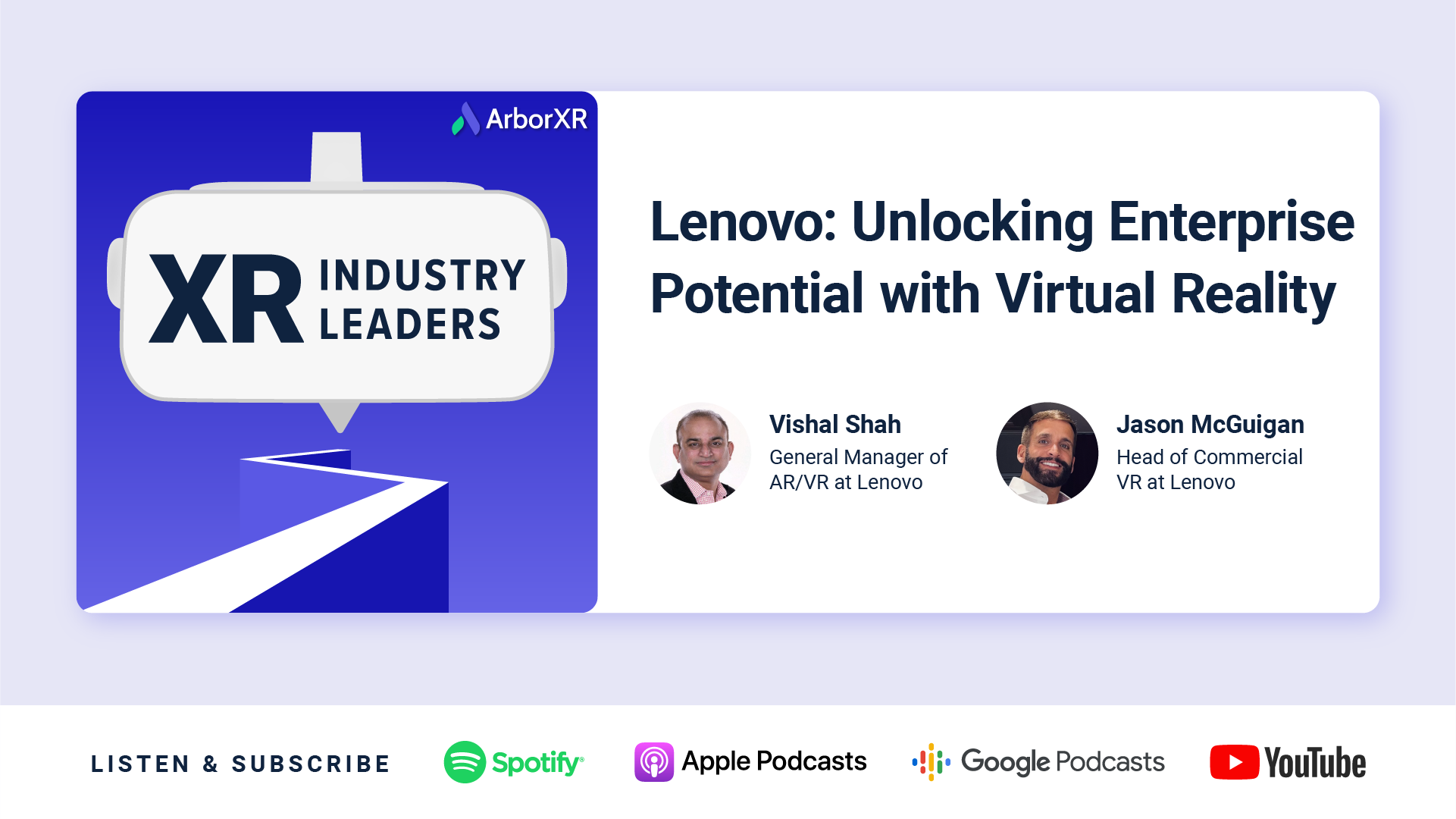
Lenovo: Unlocking Enterprise Potential with VR
Dive into the dynamic world of extended reality (XR) with Lenovo’s Vishal Shah and Jason McGuigan as they unravel Lenovo’s new enterprise XR solution: the Lenovo ThinkReality VRX.

PICO: Practical Enterprise Applications in XR at Scale
Explore XR’s future with PICO’s Amir Khorram in XR Industry Leaders. Insightful discussion on VR enterprise solutions, partnerships, and industry adoption.
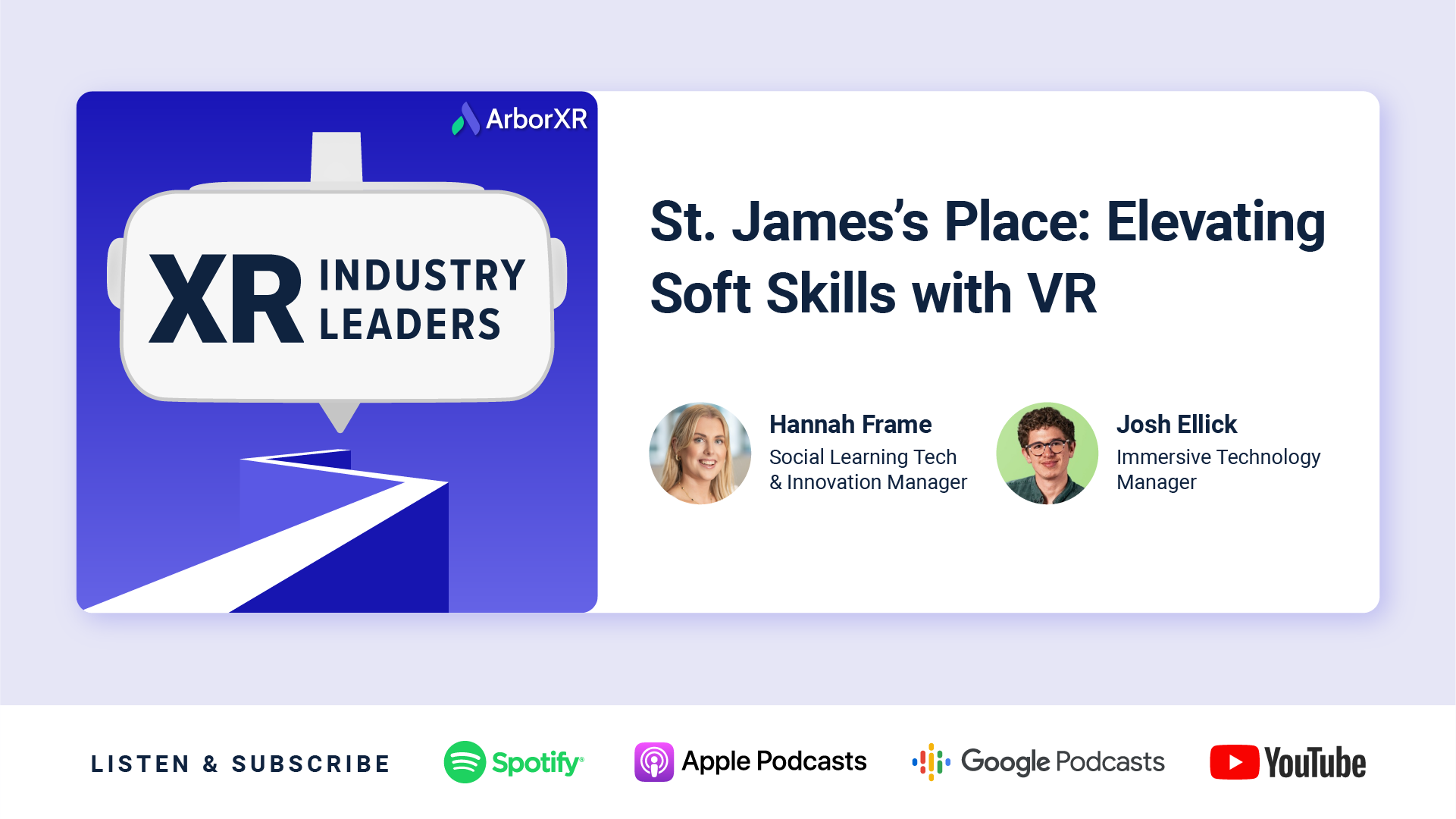
St. James’s Place: Elevating Soft Skills with VR
Hannah & Josh St. James’s Place discuss using VR to train advisor soft skills, challenges of managing headsets at scale, lessons on user adoption, and content development.
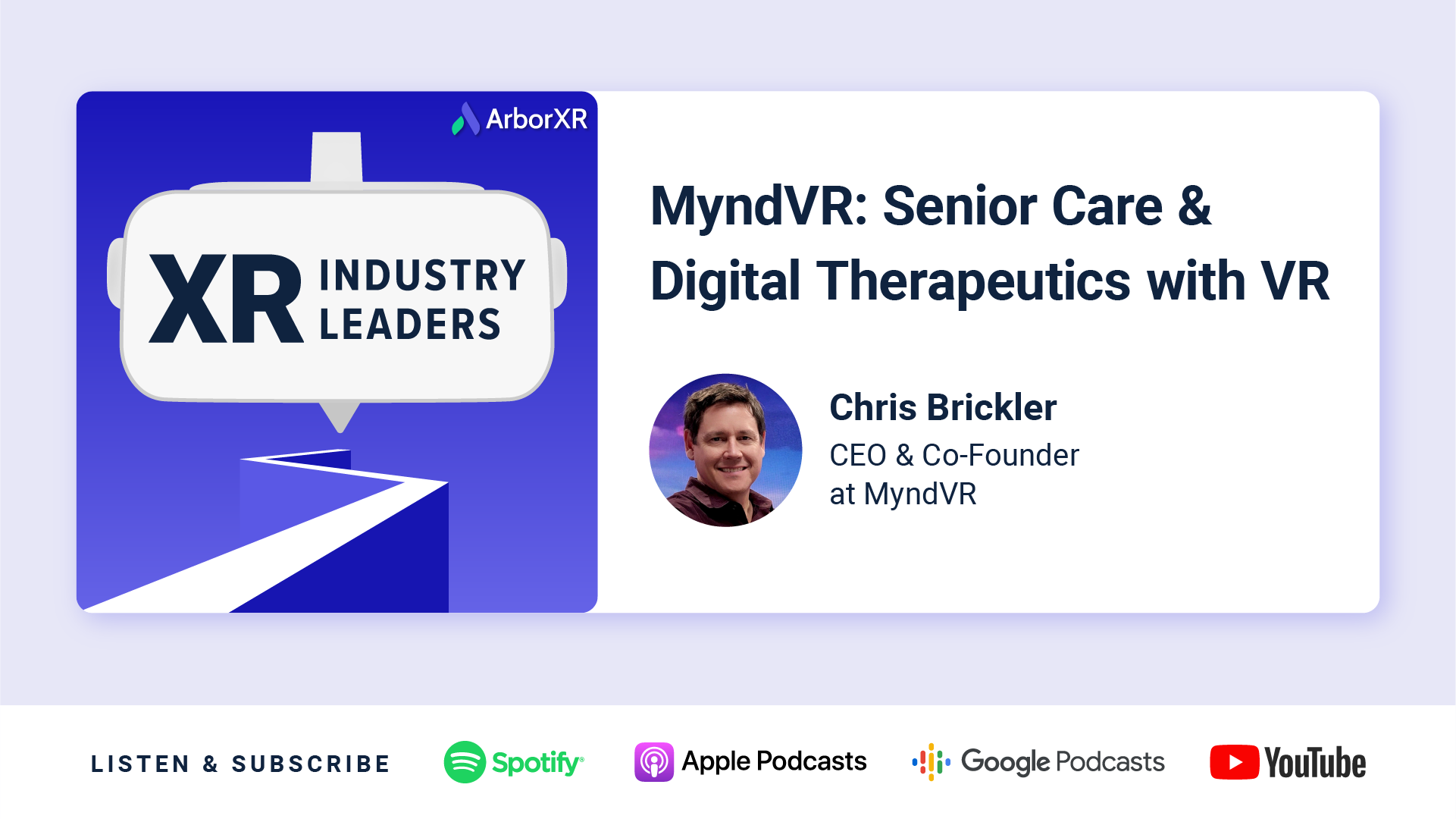
MyndVR: Senior Care and Digital Therapeutics with VR
Chris Brickler shares how VR therapy improves memories and care for elderly patients, and the challenges of scaling VR across health senior care facilities.
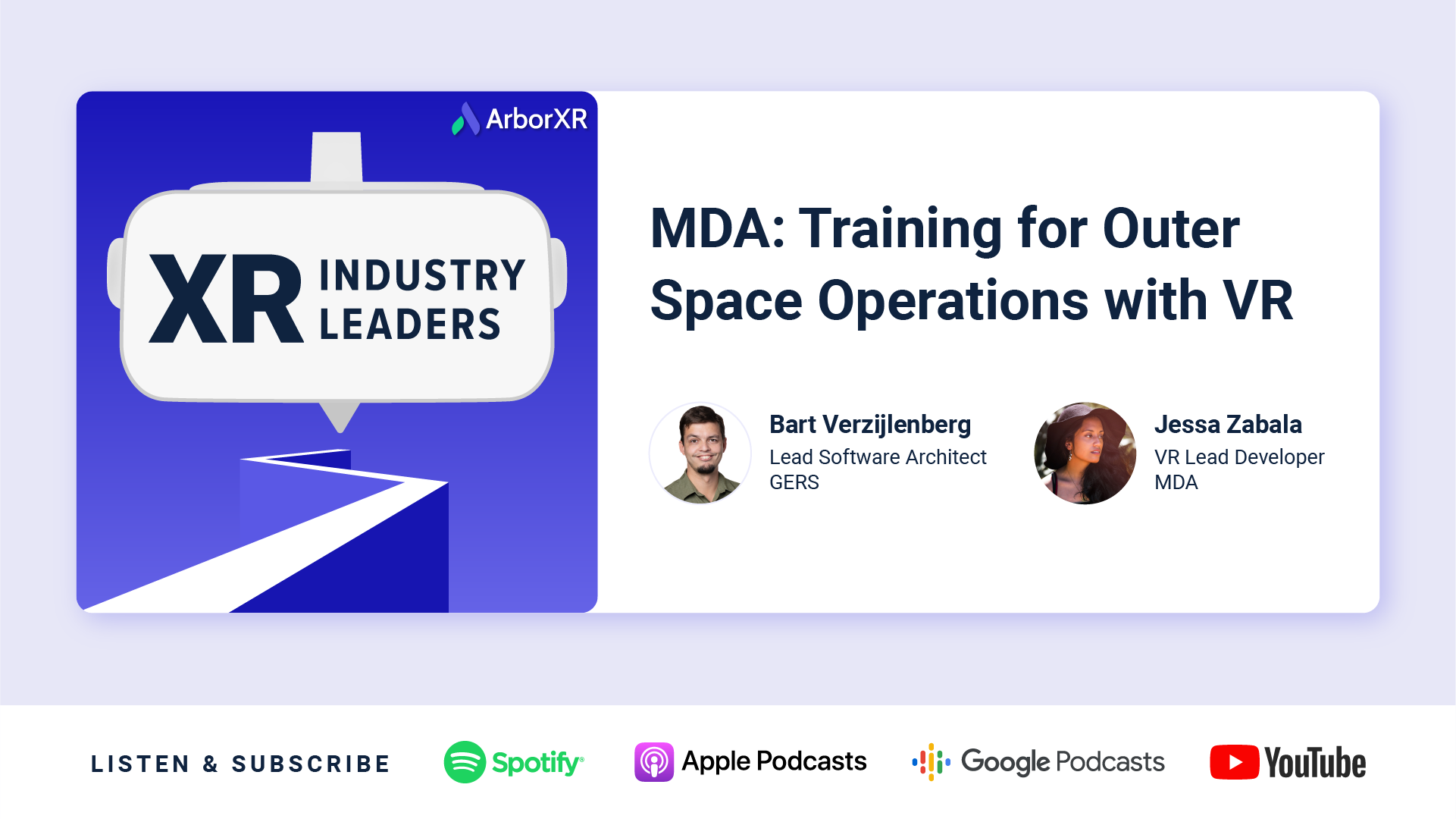
MDA: Training For Outer Space Operations with VR
Discover how MDA leverages VR for astronaut training, mission planning, and onboarding. Gain valuable insights into implementing immersive technologies at scale.

Harvard: Experiential VR Learning in Education
Matt Cook from Harvard joins us to discuss how virtual & augmented reality are redefining higher education through customized immersive experiences.
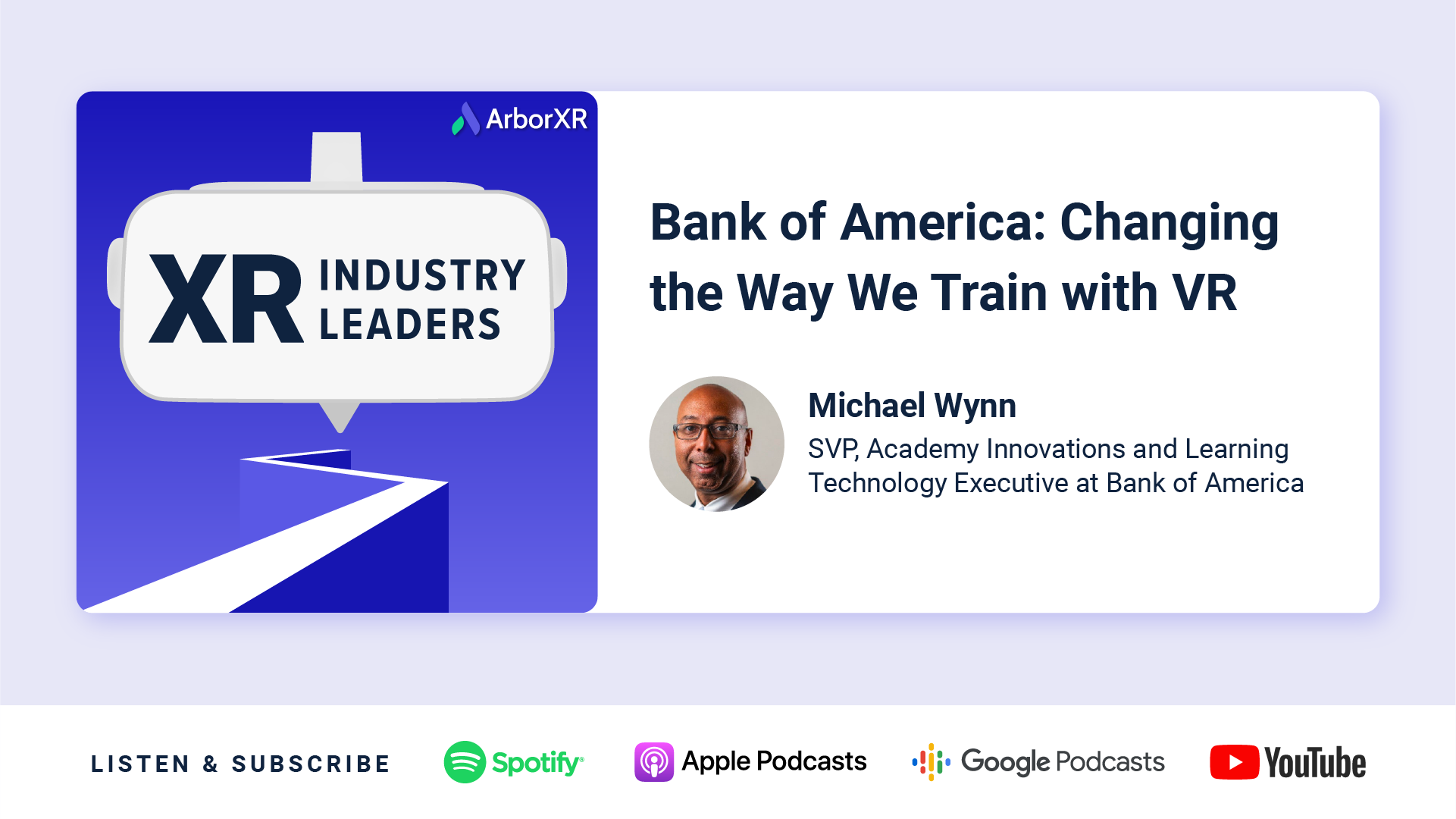
Bank of America: Changing the Way We Train with VR
Explore how Bank of America is revolutionizing training with VR, enhancing employee engagement, overcoming challenges with VR, and redefining corporate education.
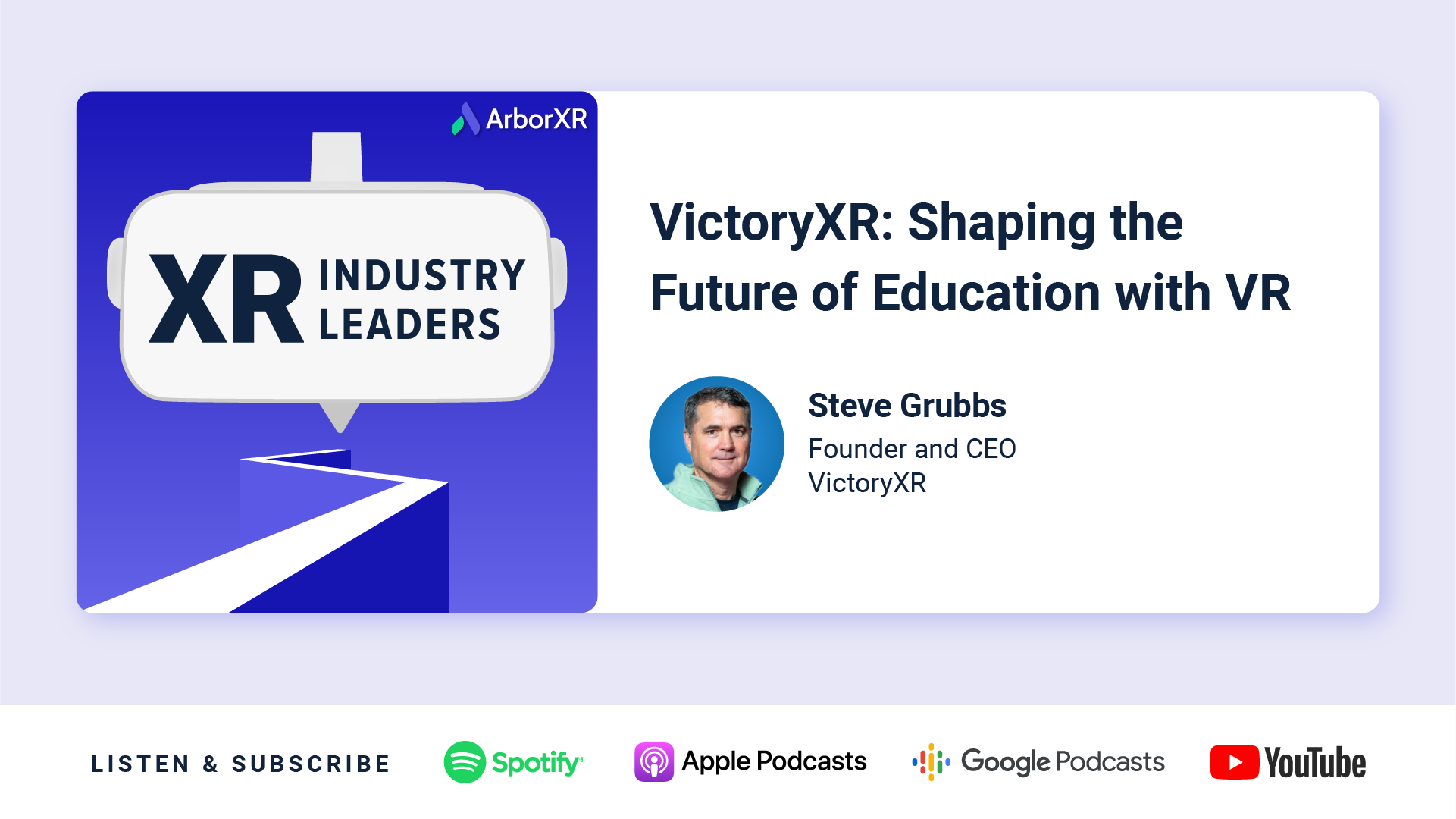
VictoryXR: Shaping the Future of Education with VR
VictoryXR CEO Steve Grubbs discusses creating virtual reality curriculums for education, working closely with Meta, and the future of immersive technology for teachers and students.

VRpatients: Designing Your Own VR Training for Healthcare
Learn how VRpatients creates VR simulations that instructors can customize to give trainees real-life experiences in healthcare.
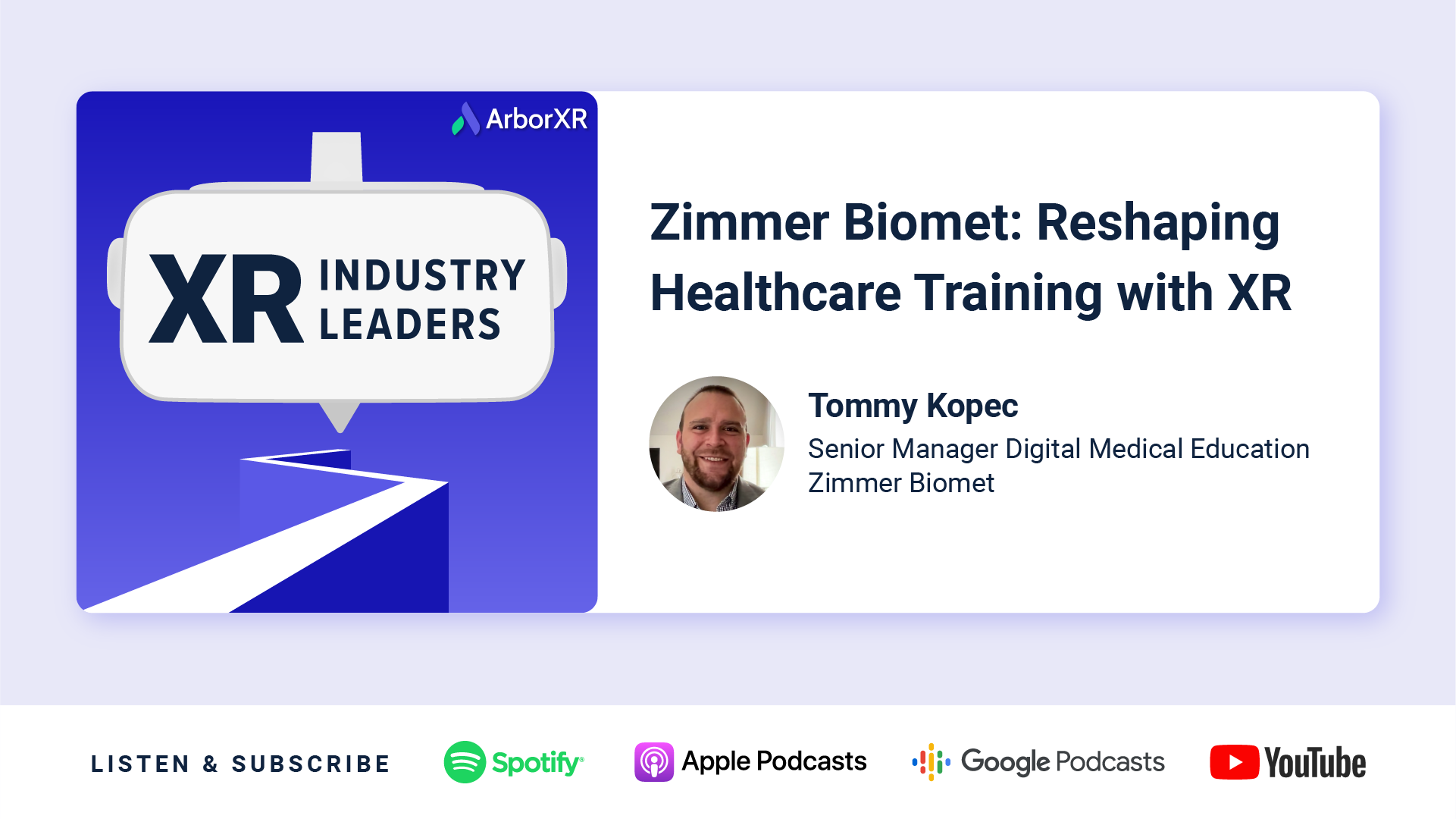
Zimmer Biomet: Reshaping Healthcare Training with AR and VR
If you’re interested in how XR will shape medicine going forward, this is a must-listen episode. Tommy Kopec of Zimmer Biomet provides an insider’s perspective on VR’s transformative potential for surgery, training, and beyond.
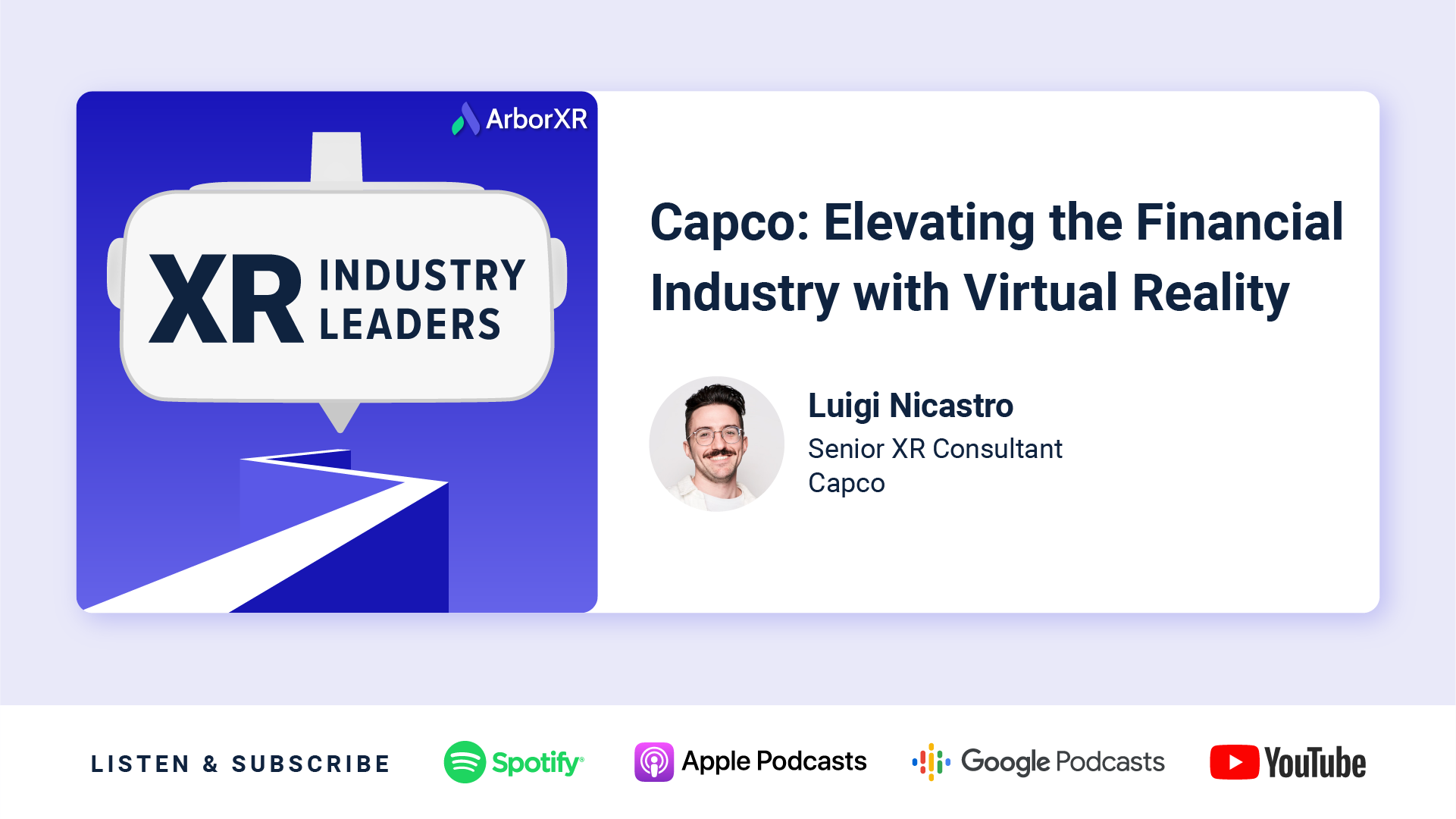
Capco: Elevating the Financial Industry with Virtual Reality
Explore how Capco revolutionizes the financial industry with virtual reality. Discover their success, challenges, and predictions for VR’s impact.

MIT: Exploring Extended Reality in Historic Operas
Discover how MIT uses AR and VR to create immersive experiences for historic operas. We discuss XR in education, challenges and advice for new adopters, and more.

Magic Leap: How Augmented Reality is Elevating Enterprise
Discover how Magic Leap is taking augmented reality to the next level with their enterprise-focused hardware, including real-world statistics and use cases.

Bodyswaps: Innovating Soft Skills Training with Virtual Reality
Discover the future of VR in education with Bodyswaps. Learn how VR elevates soft skills training, and how to implement VR technology effectively.
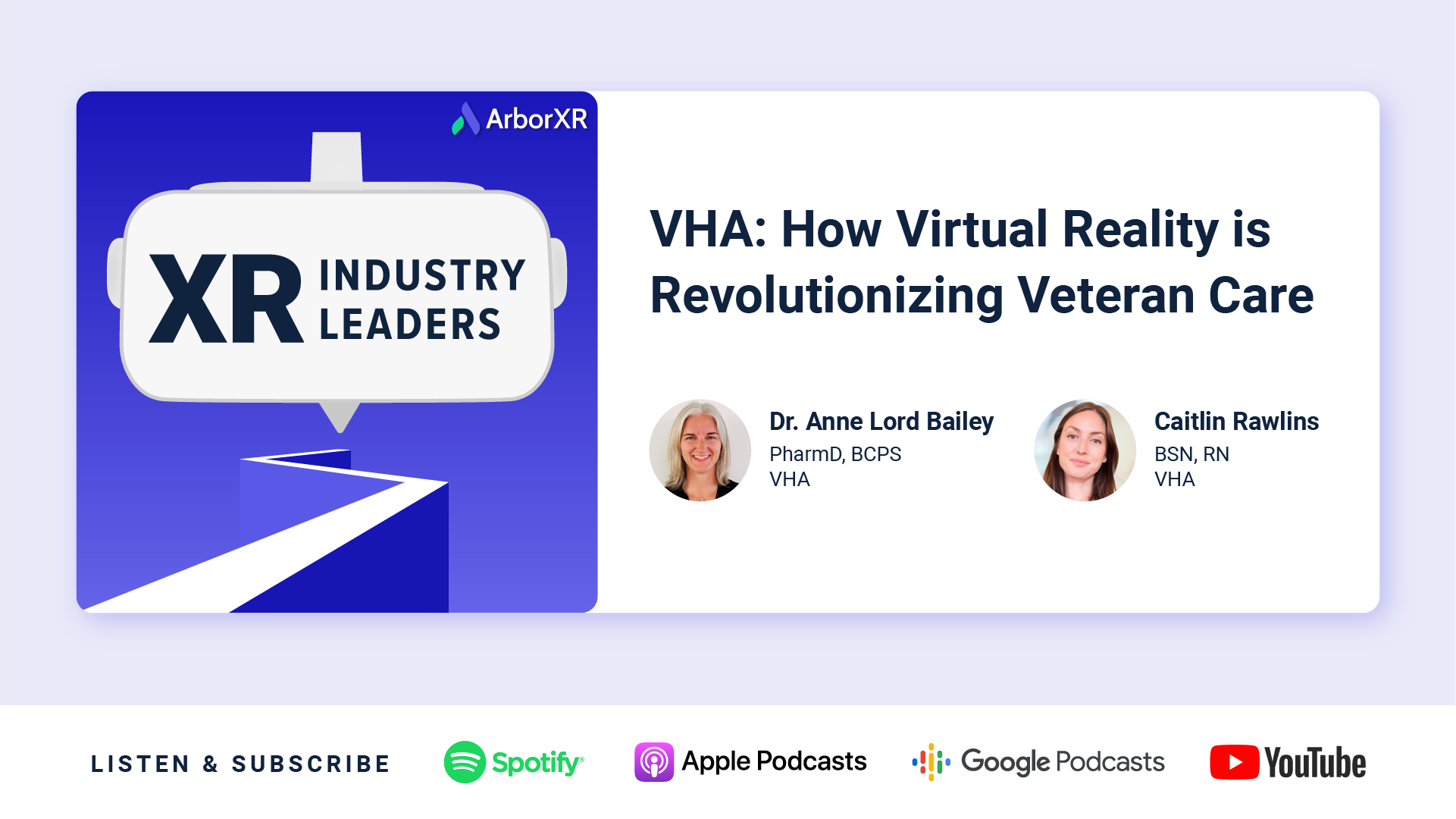
VHA: How Virtual Reality is Revolutionizing Veteran Care
Discover how the VHA is using virtual reality to improve the lives of veterans with pain management, mental health, and overall well-being.
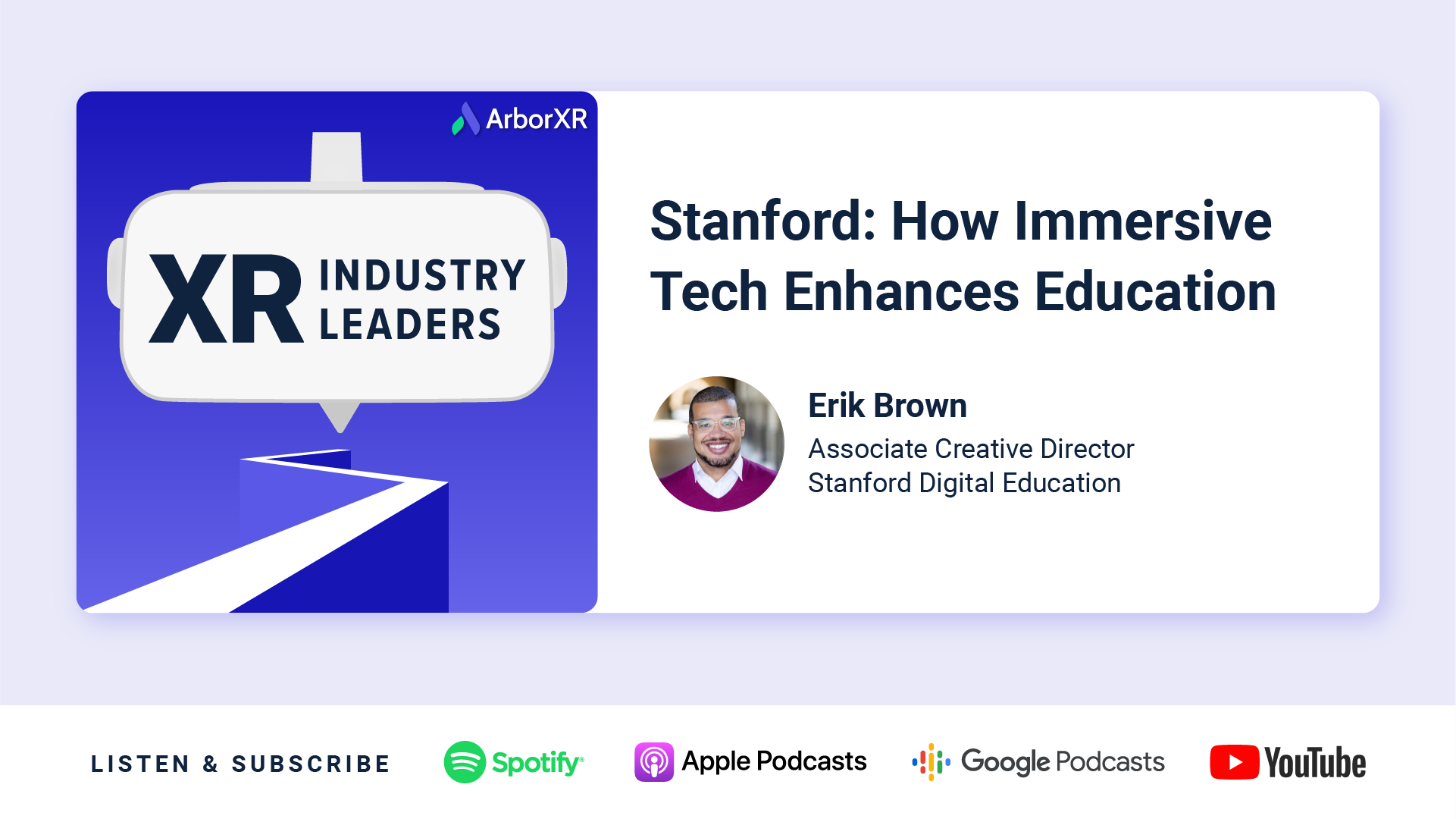
Stanford: How Immersive Technology Enhances Education
Erik Brown discusses how Stanford uses virtual reality for education, empathy in VR, challenges with creating and managing XR content, and more.
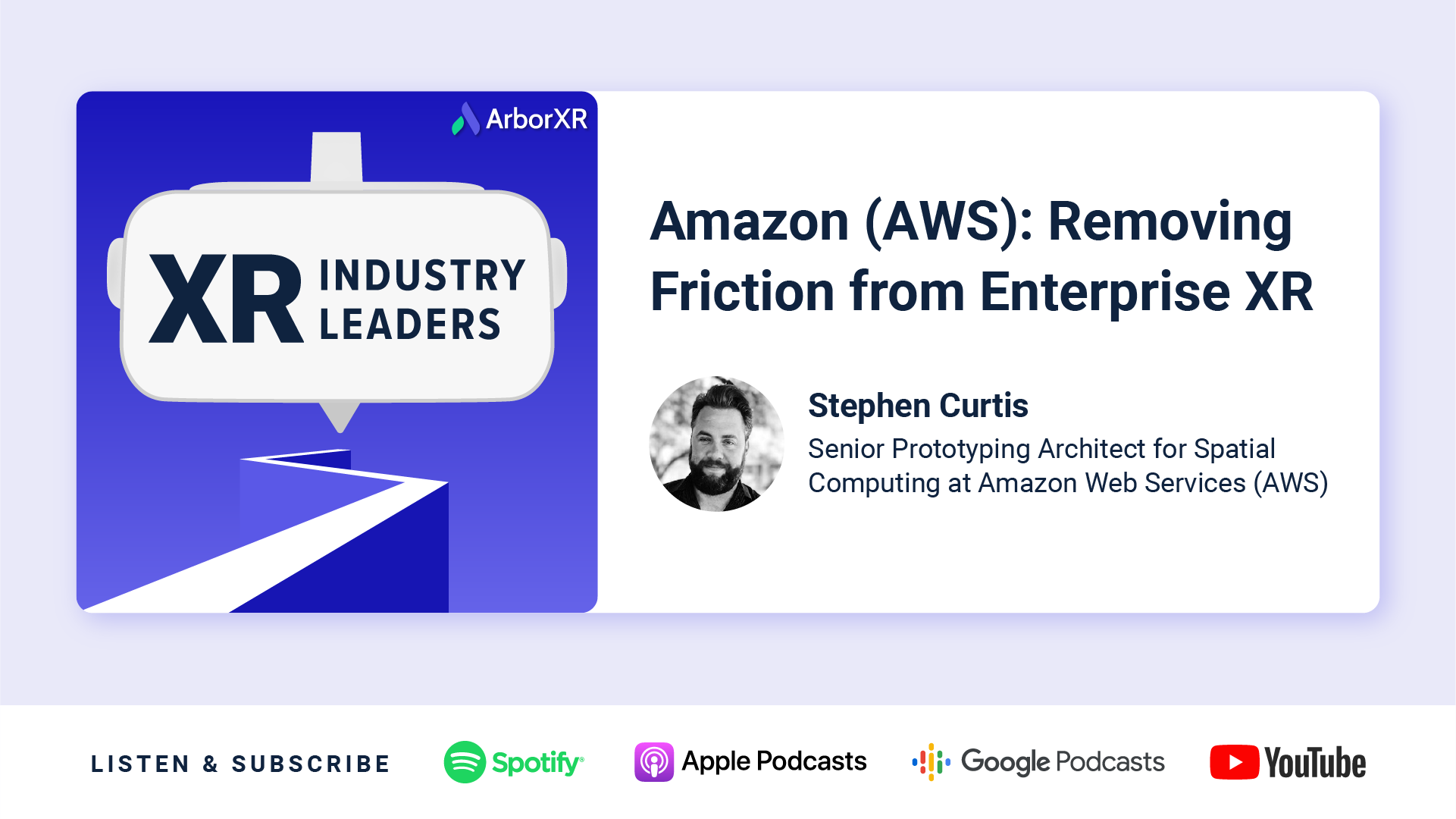
Amazon (AWS): Removing Friction from Enterprise XR
Stephen Curtis from AWS discusses how XR solves enterprise friction, advice for new adopters, XR content authoring, XR device management and more.

WestRock: How XR is Accelerating Manufacturing
XR champion Scott Burkey discusses the impact AR and VR is having on manufacturing, challenges implementing new technology, and advice for using XR in business.

Pfizer: Transforming How We Train with XR
XR leader Nicholas Hockley discusses how XR transformed the way Pfizer trains, challenges with AR/VR content, moving from a pilot program to scale, and more.
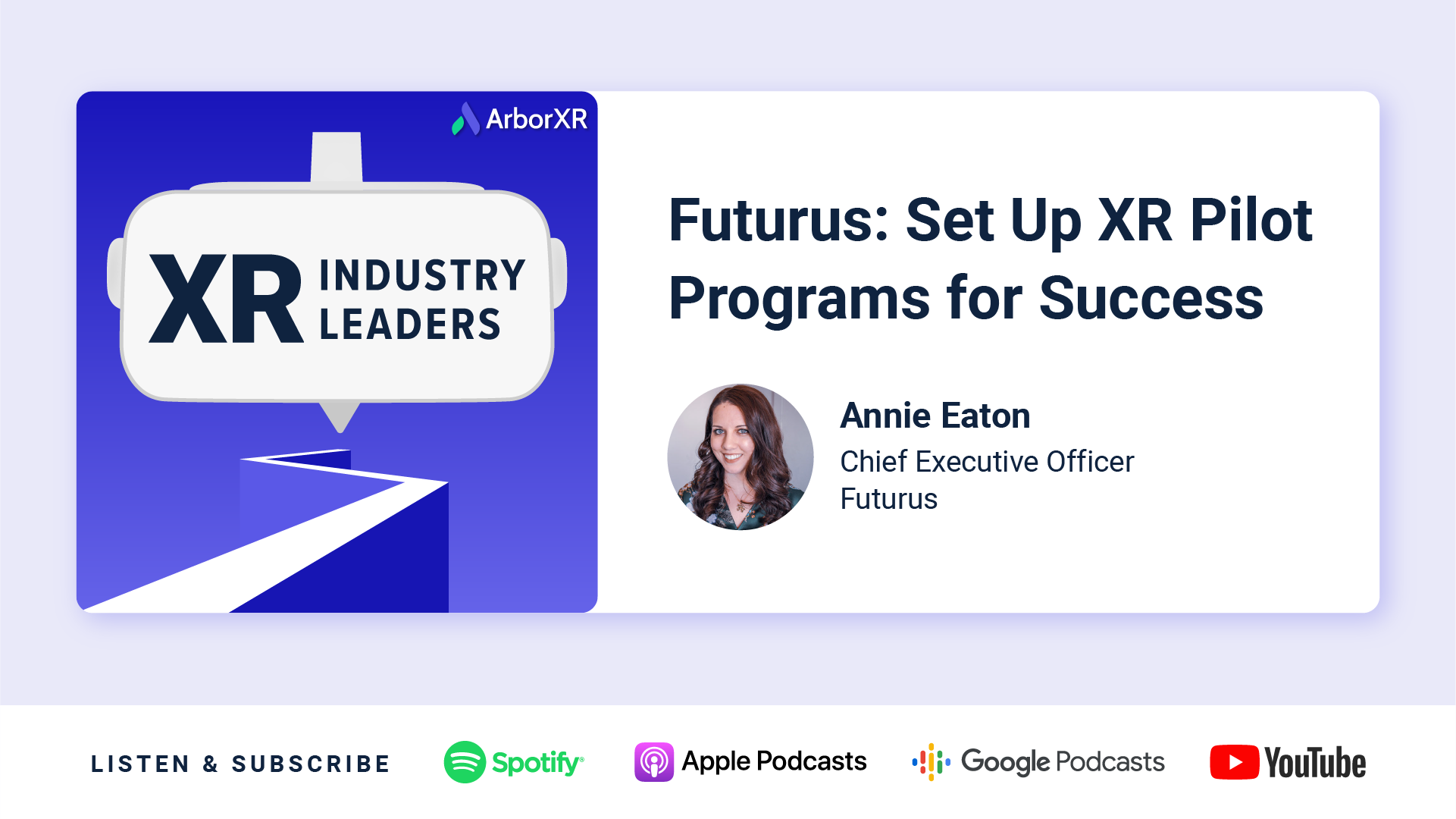
Futurus: Set Up XR Pilot Programs for Success
Futurus CEO Annie Eaton discusses creating AR/VR content, how to set up XR pilot programs for success, challenges in XR, advice for new adopters, and more.
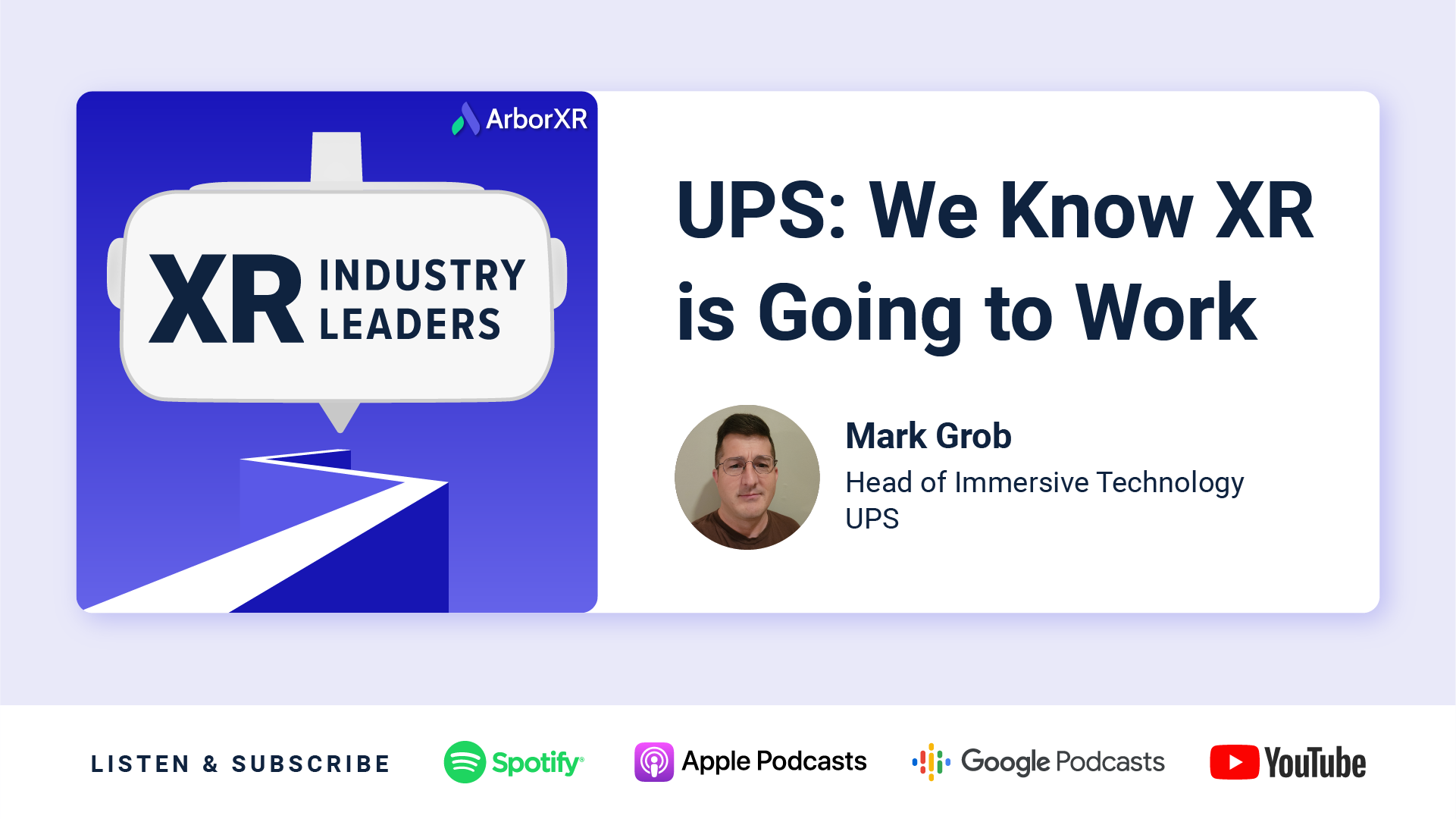
UPS: We Know XR is Going to Work
Learn how UPS built XR training as a practice. We discuss using AR/VR in business, challenges and benefits of XR training, advice for new adopters & more.

INVISTA (Koch Industries): What if We Reimagined Our Entire Training Process?
Learn how XR is transforming INVISTA (Koch). We discuss using AR/VR in business, challenges and benefits of XR training, strategy to scaling XR adoption & more.

Lenovo: Unlocking Enterprise Potential with VR
Dive into the dynamic world of extended reality (XR) with Lenovo’s Vishal Shah and Jason McGuigan as they unravel Lenovo’s new enterprise XR solution: the Lenovo ThinkReality VRX.

PICO: Practical Enterprise Applications in XR at Scale
Explore XR’s future with PICO’s Amir Khorram in XR Industry Leaders. Insightful discussion on VR enterprise solutions, partnerships, and industry adoption.

St. James’s Place: Elevating Soft Skills with VR
Hannah & Josh St. James’s Place discuss using VR to train advisor soft skills, challenges of managing headsets at scale, lessons on user adoption, and content development.

MyndVR: Senior Care and Digital Therapeutics with VR
Chris Brickler shares how VR therapy improves memories and care for elderly patients, and the challenges of scaling VR across health senior care facilities.

MDA: Training For Outer Space Operations with VR
Discover how MDA leverages VR for astronaut training, mission planning, and onboarding. Gain valuable insights into implementing immersive technologies at scale.

Harvard: Experiential VR Learning in Education
Matt Cook from Harvard joins us to discuss how virtual & augmented reality are redefining higher education through customized immersive experiences.

Bank of America: Changing the Way We Train with VR
Explore how Bank of America is revolutionizing training with VR, enhancing employee engagement, overcoming challenges with VR, and redefining corporate education.

VictoryXR: Shaping the Future of Education with VR
VictoryXR CEO Steve Grubbs discusses creating virtual reality curriculums for education, working closely with Meta, and the future of immersive technology for teachers and students.

VRpatients: Designing Your Own VR Training for Healthcare
Learn how VRpatients creates VR simulations that instructors can customize to give trainees real-life experiences in healthcare.

Zimmer Biomet: Reshaping Healthcare Training with AR and VR
If you’re interested in how XR will shape medicine going forward, this is a must-listen episode. Tommy Kopec of Zimmer Biomet provides an insider’s perspective on VR’s transformative potential for surgery, training, and beyond.
